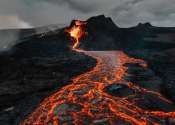Colorful, melodious birds at risk from poor urban planning
Research led by Griffith University reveals how urban areas in Brisbane are losing bird species with characteristics that people find most "aesthetically pleasing."

Research led by Griffith University reveals how urban areas in Brisbane are losing bird species with characteristics that people find most "aesthetically pleasing."
Plants & Animals
Sep 3, 2024
0
27

A QUT study analyzing five decades of research and thousands of studies has identified five critical areas needed to tackle urban heat vulnerability (UHV), a growing issue impacting millions in increasingly heat-prone cities.
Environment
Aug 30, 2024
0
12

Leafy greens such as spinach and lettuce are among the most nutrient-packed foods we can eat—and some of the most prone to make us miserable, or worse. The pathogenic bacterium Escherichia coli O157:H7 causes millions of ...
Cell & Microbiology
Aug 28, 2024
0
6

A study conducted across 30 field sites in the southwest UK has revealed the importance of incorporating varied habitats into the landscape at large.
Plants & Animals
Aug 21, 2024
0
14

Scientists have found a new way to predict how proteins change their shape when they function, which is important for understanding how they work in living systems. While recent artificial intelligence (AI) technology has ...
Biotechnology
Aug 20, 2024
0
202

Remote sensing plays a vital role in monitoring agricultural landscapes, yet current satellite sensors often struggle with the trade-off between spatial and temporal resolution.
Biotechnology
Aug 15, 2024
0
8

In 2022, an international team forming the Joint Mongolian-Israeli-American Archaeological Project excavated an abandoned frontier fortress. They made an unexpected discovery: an elite grave buried in the walls of an abandoned ...

University of the Sunshine Coast researchers have confirmed the happy place of one of Australia's smelliest and messiest native birds—the white ibis—and as expected, the closer to rubbish dumps the better.
Plants & Animals
Aug 9, 2024
0
44

Scientists often seek answers to humanity's most pressing challenges in nature. When it comes to global warming, geological history offers a unique, long-term perspective.
Earth Sciences
Aug 8, 2024
0
283

The Park Fire is the fifth-largest wildfire in the history of California, having burned about 390,000 acres and destroyed more than 400 structures. Authorities say it began when a man pushed a burning car into a ravine, and ...
Environment
Aug 5, 2024
0
15
Landscape comprises the visible features of an area of land, including the physical elements of landforms such as (ice-capped) mountains, hills, water bodies such as rivers, lakes, ponds and the sea, living elements of land cover including indigenous vegetation, human elements including different forms of land use, buildings and structures, and transitory elements such as lighting and weather conditions.
Combining both their physical origins and the cultural overlay of human presence, often created over millennia, landscapes reflect the living synthesis of people and place vital to local and national identity. Landscapes, their character and quality, help define the self image of a region, its sense of place that differentiates it from other regions. It is the dynamic backdrop to people’s lives.
The Earth has a vast range of landscapes including the icy landscapes of polar regions, mountainous landscapes, vast arid desert landscapes, islands and coastal landscapes, densely forested or wooded landscapes including past boreal forests and tropical rainforests, and agricultural landscapes of temperate and tropical regions.
Landscape may be further reviewed under the following specific categories: cultural landscape, landscape ecology, landscape planning, landscape assessment and landscape design.
This text uses material from Wikipedia, licensed under CC BY-SA